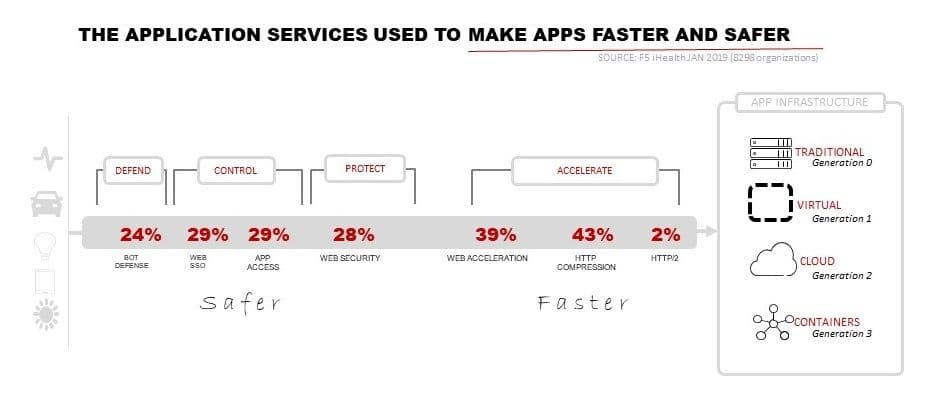Welcome back! This quarter's interesting movement in application services was on all things programmable. From the data path (iRules) to application routing (rewrite) and visibility (x-forward-for), the use of programmability increased quarter over quarter.
While most of the focus of programmability is on operations today, there remains a significant amount of data path programmability that's vital to enabling consumers to interact with applications. In general, data path programmability via iRules rose 2% to end the quarter with 83% of organizations taking advantage of its capabilities. Organizations use iRules to customize and codify processes that govern the flow of traffic from client to application. Because iRules allow you to intercept and interact with real-time requests and responses, the potential use cases are as varied as the applications and workflows it supports.
The biggest move of all (+3%) was for the ever popular (and necessary) x-forwarded-for capability that enables visibility of client IP addresses to the applications that need it. Also growing was the use of rewriting capabilities, which allows operators to map inbound URIs to internal URIs transparently. This capability is often used to migrate versions of APIs, websites, or to build out an API façade without requiring additional infrastructure.

DEFEND | CONTROL & PROTECT | LOCATION |
|---|---|---|
DEFENSES GROWING | SECURITY INCREASES | PERFORMANCE GAINS |
Unsurprisingly, Bot defense services rose 2% over last quarter to end at nearly one quarter (24%) of organizations. Other defensive application services also saw slight gains with web security in particularly rising 1%. Research from F5 Labs proposed that half of all Internet traffic originates with bots. Nearly one third (30%) of these are malicious. | Security services made slight gains quarter of quarter, as well, with single sign on growing from 28% to 29% of organizations and application access matching those gains. Given the preponderance of respondents to our State of Application Services 2019 survey that would not deploy an application without security, we're not surprised by the slow but steady gains made by security-related application services. | In a pattern that's repeated for several years now, performance has regained losses from previous quarters with caching, web acceleration, and TCP multiplexing all gaining 2% quarter over quarter. HTTP/2 remains at a sluggish 2% of organizations and with the news of HTTP/3 coming, we expect this will to remain low until the newest version of HTTP is ratified and widely available. |
For more insights on application services, be sure to check out our State of Application Services 2019 report, and watch for the next edition of our Application Services Update next quarter.
About the Author

Related Blog Posts

AppViewX + F5: Automating and orchestrating app delivery
As an F5 ADSP Select partner, AppViewX works with F5 to deliver a centralized orchestration solution to manage app services across distributed environments.

Build a quantum-safe backbone for AI with F5 and NetApp
By deploying F5 and NetApp solutions, enterprises can meet the demands of AI workloads, while preparing for a quantum future.

F5 ADSP Partner Program streamlines adoption of F5 platform
The new F5 ADSP Partner Program creates a dynamic ecosystem that drives growth and success for our partners and customers.
F5 NGINX Gateway Fabric is a certified solution for Red Hat OpenShift
F5 collaborates with Red Hat to deliver a solution that combines the high-performance app delivery of F5 NGINX with Red Hat OpenShift’s enterprise Kubernetes capabilities.
F5 Silverline Mitigates Record-Breaking DDoS Attacks
Malicious attacks are increasing in scale and complexity, threatening to overwhelm and breach the internal resources of businesses globally. Often, these attacks combine high-volume traffic with stealthy, low-and-slow, application-targeted attack techniques, powered by either automated botnets or human-driven tools.
Phishing Attacks Soar 220% During COVID-19 Peak as Cybercriminal Opportunism Intensifies
David Warburton, author of the F5 Labs 2020 Phishing and Fraud Report, describes how fraudsters are adapting to the pandemic and maps out the trends ahead in this video, with summary comments.
